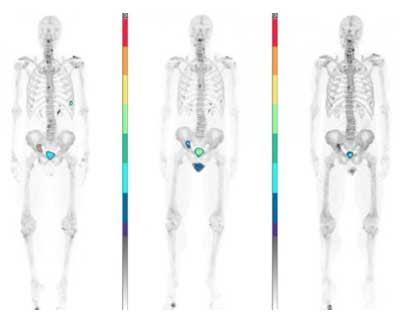- Home
- Editorial
- News
- Practice Guidelines
- Anesthesiology Guidelines
- Cancer Guidelines
- Cardiac Sciences Guidelines
- Critical Care Guidelines
- Dentistry Guidelines
- Dermatology Guidelines
- Diabetes and Endo Guidelines
- Diagnostics Guidelines
- ENT Guidelines
- Featured Practice Guidelines
- Gastroenterology Guidelines
- Geriatrics Guidelines
- Medicine Guidelines
- Nephrology Guidelines
- Neurosciences Guidelines
- Obs and Gynae Guidelines
- Ophthalmology Guidelines
- Orthopaedics Guidelines
- Paediatrics Guidelines
- Psychiatry Guidelines
- Pulmonology Guidelines
- Radiology Guidelines
- Surgery Guidelines
- Urology Guidelines
Predicting Advanced Prostate Cancer Outcomes with NaF-PET/CT

Reston : A recent pilot study reported in the June issue of The Journal of Nuclear Medicine found that sodium fluoride (Na-F-18) positron emission tomography/computed tomography (NaF-PET/CT) accurately detects bone metastases in patients with advanced prostate cancer, and follow-up scans over time correlate clearly with clinical outcomes and patient survival.
According to the Centers for Disease Control and Prevention, in 2012 (the most recent year for which numbers are available) 177,489 men in the United States were diagnosed with prostate cancer, and 27,244 men in the U.S. died from the disease.
Andrea B. Apolo, MD, chief of the Bladder Cancer Section, Center for Cancer Research, at the National Cancer Institute in Bethesda, Md., said, “To our knowledge, this is the first report of follow-up NaF scans of prostate cancer patients over a one-year period correlated with survival. The findings in this study provide support for the use of NaF-PET/CT in clinical practice in patients with advanced prostate cancer.”
Sixty prostate cancer patients, including 30 with and 30 without known bone metastases by conventional imaging, underwent NaF-PET/CT at baseline, 6, and 12 months. Positive lesions were verified on follow-up scans. Changes in standardized uptake values (SUV) and lesion number were correlated with prostate-specific antigen (PSA) change, clinical impression, and overall survival. Also, greater change in SUV at 6 and 12 months correlated with greater change in PSA.
In an exploratory analysis, paired Tc-99m-MDP bone scans (TcBS) were available in 35 patients at baseline, 19 at 6 months, and 14 at 12 months. Malignant lesions on NaF-PET/CT were classified on TcBS as malignant only 65 percent of the time; 25 percent were indeterminate; and 10 percent were negative. In addition, 65 percent of paired scans showed more lesions on NaF-PET/CT than on TcBS.
The study shows that NaF-PET/CT detects more bone metastases earlier than TcBS and enhances detection of new bone disease in high-risk patients.
Apolo stated, “Our study suggests that NaF-PET/CT may be a useful imaging modality in the diagnosis, prognosis and follow-up of prostate cancer patients at high risk for bone metastasis. It provides a strong rational to further the clinical development of NaF-PET/CT as a bone imaging tool in prostate cancer and other malignancies.

Disclaimer: This site is primarily intended for healthcare professionals. Any content/information on this website does not replace the advice of medical and/or health professionals and should not be construed as medical/diagnostic advice/endorsement or prescription. Use of this site is subject to our terms of use, privacy policy, advertisement policy. © 2020 Minerva Medical Treatment Pvt Ltd